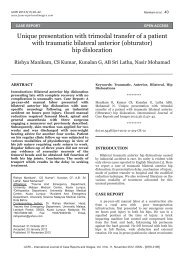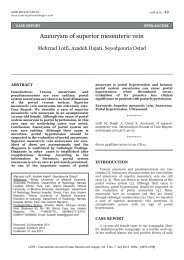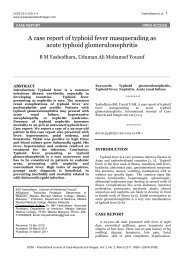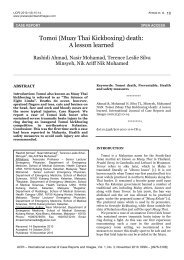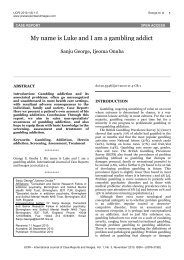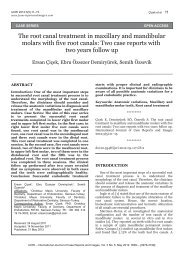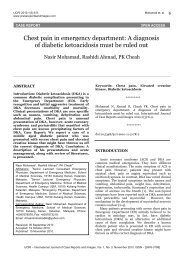Full Text PDF - International Journal of Case Reports and Images ...
Full Text PDF - International Journal of Case Reports and Images ...
Full Text PDF - International Journal of Case Reports and Images ...
Create successful ePaper yourself
Turn your PDF publications into a flip-book with our unique Google optimized e-Paper software.
IJCRI 201 2;3(8):27–30.<br />
www.ijcasereports<strong>and</strong>images.com<br />
Vonbank et al. 27<br />
CASE REPORT<br />
OPEN ACCESS<br />
Is sodium thiosulfate a therapeutic option for<br />
nonuremic calciphylaxis?<br />
Alex<strong>and</strong>er Vonbank, Christoph Mayr,<br />
Edgar Meusburger, Karl Lhotta<br />
ABSTRACT<br />
Introduction: Nonuremic calciphylaxis, a rare<br />
disorder with high mortality, is associated with<br />
severe calcifications <strong>of</strong> the media <strong>of</strong> arterioles<br />
which cause vascular occlusion <strong>and</strong> tissue<br />
necrosis. <strong>Case</strong> Report: A nonuremic calciphylaxis<br />
<strong>of</strong> the lower limb, possibly caused by coumarin<br />
therapy for atrial fibrillation. Treatment<br />
consisting <strong>of</strong> coumarin avoidance, vitamin K<br />
supplementation <strong>and</strong> thrice weekly infusion <strong>of</strong><br />
20 g <strong>of</strong> sodium thiosulfate for three weeks led to<br />
complete healing <strong>of</strong> the leg ulcers. Conclusion:<br />
Sodium thiosulfate produces a considerable<br />
sodium load <strong>and</strong> may induce a decrease in<br />
serum calcium, potassium <strong>and</strong> phosphate levels<br />
as well as an increase in the anion gap. We<br />
suggest that sodium thiosulfate is effective in the<br />
treatment <strong>of</strong> nonuremic calciphylaxis, but its<br />
use requires monitoring <strong>of</strong> electrolytes, acidbase<br />
<strong>and</strong> volume status. Based on previous<br />
studies <strong>of</strong> sodium thiosulfate pharmacokinetics<br />
in individuals with normal renal function, which<br />
showed rapid excretion by the kidneys,<br />
application as a slow infusion over several hours<br />
Ashish Bhargava 1 , Vasavi Paidpally 2 , Pragati Bhargava 2 ,<br />
Alex<strong>and</strong>er Vonbank 1 ,2,3 , Christoph Mayr 1 , Edgar<br />
Meusburger 1 , Karl Lhotta 1 ,2<br />
Affiliations: 1<br />
Department <strong>of</strong> Nephrology <strong>and</strong> Dialysis,<br />
Academic Teaching Hospital Feldkirch, Austria,<br />
2<br />
Vorarlberg Institute for Vascular Investigation <strong>and</strong><br />
Treatment (VIVIT), Feldkirch, Austria, 3<br />
Private University<br />
<strong>of</strong> the Principality <strong>of</strong> Liechtenstein, Triesen, Liechtenstein.<br />
Corresponding Author: Alex<strong>and</strong>er Vonbank, Department <strong>of</strong><br />
Nephrology <strong>and</strong> Dialysis, Academic Teaching Hospital<br />
Feldkirch, Carinagasse 47, A-6800 Feldkirch, Austria; Ph:<br />
+43 5522 303 2670; Fax: +43 5522 303 7506; Email:<br />
alex<strong>and</strong>er.vonbank@lkhf.at<br />
Received: 02 February 201 2<br />
Accepted: 07 April 201 2<br />
Published: 01 August 201 2<br />
is recommended in order to enhance its efficacy<br />
<strong>and</strong> avoid unwanted side effects.<br />
Keywords: Calciphylaxis, Sodium thiosulfate,<br />
Pharmacokinetics<br />
*********<br />
Vonbank A, Mayr C, Meusburger E, Lhotta K. Is sodium<br />
thiosulfate a therapeutic option for nonuremic<br />
calciphylaxis? <strong>International</strong> <strong>Journal</strong> <strong>of</strong> <strong>Case</strong> <strong>Reports</strong><br />
<strong>and</strong> <strong>Images</strong> 2012;3(8):27–30.<br />
*********<br />
doi:10.5348/ijcri201208161CR8<br />
INTRODUCTION<br />
Calcific uremic arteriolopathy (CUA), also called<br />
calciphylaxis, is a rare small vessel disease almost<br />
exclusively found in patients with endstage renal<br />
disease [1].<br />
Severe calcification <strong>of</strong> the media <strong>of</strong> arterioles cause<br />
vascular occlusion <strong>and</strong> tissue necrosis. The pathogenesis<br />
<strong>of</strong> the condition is incompletely understood. It appears<br />
to be associated with deranged calcium <strong>and</strong> phosphate<br />
metabolism <strong>and</strong> a lack <strong>of</strong> inhibitors <strong>of</strong> calcification<br />
secondary to chronic kidney disease [2]. Compared to<br />
CUA, coumarin necrosis is associated with proteinc<br />
deficiency <strong>and</strong> local microthromboembolic events. Nonuremic<br />
calciphylaxis (NUC) seems to be extremely rare.<br />
A recent review <strong>of</strong> literature described 36 cases <strong>of</strong> NUC<br />
[3]. According to this report, NUC is associated with a<br />
high mortality <strong>of</strong> 52% <strong>and</strong> an effective treatment for this<br />
condition does not exist [3].<br />
A patient with NUC who had a complete remission<br />
under sodium thiosulfate (STS) therapy <strong>and</strong> explain the<br />
alterations in serum <strong>and</strong> urinary electrolytes caused by<br />
STS is discussed here.<br />
IJCRI – <strong>International</strong> <strong>Journal</strong> <strong>of</strong> <strong>Case</strong> <strong>Reports</strong> <strong>and</strong> <strong>Images</strong>, Vol. 3 No. 8, August 201 2. ISSN – [0976-31 98]
IJCRI 201 2;3(8):27–30.<br />
www.ijcasereports<strong>and</strong>images.com<br />
Vonbank et al. 29<br />
Figure 2: A photograph taken two months later shows<br />
complete remission <strong>and</strong> healing <strong>of</strong> the ulcers.<br />
Cicone et al. [8] reported the first case <strong>of</strong> successful<br />
treatment <strong>of</strong> calciphylaxis with STS in a patient with<br />
chronic renal failure in 2004.<br />
The beneficial effect was ascribed to the fact that<br />
calcium thiosulfate salts have an extremely high<br />
solubility <strong>and</strong> that STS therefore dissolves already<br />
precipitated calcium salts in the vessels. Furthermore,<br />
STS has a potent antioxidant effect, which helps<br />
neutralize reactive oxygen species, <strong>and</strong> generates the<br />
antioxidant glutathione [9]. In addition, STS is<br />
metabolized to hydrogen sulfide, a potent vasodilator.<br />
This last effect may explain the rapid improvement in<br />
pain associated with STS use. Further case reports <strong>and</strong><br />
small case series have been documented successful<br />
treatment <strong>of</strong> calciphylaxis with sodium thiosulfate [10].<br />
A 10% STS solution (100 mL) contains 40 mmol<br />
thiosulfate (TS) <strong>and</strong> 80 mval Na+. Thus, each treatment<br />
with 20 g STS contained 80 mmol TS <strong>and</strong> 160 mval Na+.<br />
In order to study any other effects <strong>of</strong> STS on<br />
electrolyte metabolism, we measured serum electrolytes<br />
immediately before <strong>and</strong> after infusion <strong>of</strong> STS. In serum,<br />
we detected a small decrease in ionised calcium,<br />
possibly caused by its complexation with TS or by an<br />
increase in renal calcium loss. This drop in ionised<br />
calcium was accompanied by an increase in the PTH<br />
level. We also found a decrease in serum potassium<br />
despite stable renal potassium excretion. Despite the<br />
sodium load, serum sodium remained constant. Another<br />
unexpected finding was a marked drop in serum<br />
phosphate levels. A possible explanation would be<br />
intracellular shifting <strong>of</strong> anionic phosphate caused by the<br />
infusion <strong>of</strong> TS anion. Previous reports describe a high<br />
anion gap acidosis in uremic patients treated with STS<br />
[8]. We observed a small decrease in pH, a drop in<br />
bicarbonate <strong>and</strong> an increase in the anion gap. Assuming<br />
that this increase <strong>of</strong> 7 mval represents TS, which is a<br />
divalent anion, a serum TS concentration <strong>of</strong> 3.5 mmol/L<br />
can be calculated.<br />
In the urine, we observed massive natriuresis<br />
accompanied by a more than tw<strong>of</strong>old increase in calcium<br />
excretion. Urinary phosphate fell, probably as a<br />
consequence <strong>of</strong> the drop in serum phosphate. We also<br />
found a marked increase in the urine anion gap from 60<br />
to 260 mval. We suspect that this unidentified anion is<br />
TS at a concentration <strong>of</strong> 100 mmol/L. From these data,<br />
we conclude that a large proportion <strong>of</strong> the infused STS<br />
were rapidly excreted by the kidneys.<br />
Under normal conditions only small amounts <strong>of</strong> TS<br />
are produced in the body by metabolism <strong>of</strong> sulfur<br />
containing amino acids. Normal serum levels are<br />
around 0.1 mmol/L [11]. The main physiologic function<br />
<strong>of</strong> TS is detoxification <strong>of</strong> cyanide to thiocyanate by the<br />
mitochondrial enzyme rhodanese (thiosulfate cyanide<br />
transsulfurase). Thiosulfate is freely filtered in the<br />
glomeruli <strong>and</strong> almost completely reabsorbed by the<br />
tubuli [11]. This is mediated by the sodium–coupled<br />
transporters NaS1 <strong>and</strong> NaS2, members <strong>of</strong> the SLC13<br />
family expressed by proximal tubular cells [12].<br />
However, tubular reabsorption capacity seems to be<br />
very limited <strong>and</strong> infused STS is rapidly excreted by the<br />
kidney. Indeed, STS infusion has been used to measure<br />
glomerular filtration rate in the past [13]. Studies <strong>of</strong> a<br />
bolus injection <strong>of</strong> 150 mg/kg STS in healthy volunteers<br />
showed a hundredfold increase in serum TS levels<br />
immediately after injection with a rapid fall towards<br />
normal levels within three hours [11]. This fall was<br />
caused by distribution <strong>of</strong> TS in the extracellular fluid<br />
<strong>and</strong> renal excretion <strong>of</strong> 42% <strong>of</strong> the injected TS in the<br />
urine within the threehour period. In another study, in<br />
which 12 g/m 2 STS was infused over six hours in<br />
patients also receiving cisplatin chemotherapy, only<br />
28% <strong>of</strong> TS was recovered in the urine up to four hours<br />
after infusion [14]. In that study peak TS concentrations<br />
in plasma were on average 1.5 mmol/L, which is<br />
considerably lower than the level estimated in our<br />
patient, <strong>and</strong> again fell to normal values within three<br />
hours. The results <strong>of</strong> these studies are in agreement with<br />
the serum <strong>and</strong> urine TS levels we derived from<br />
measuring the serum <strong>and</strong> urine anion gaps. These data<br />
also suggest that when administered at slower infusion<br />
rates more TS is retained in the body than for a bolus<br />
infusion, thus inferring that at a slow infusion rate more<br />
TS is oxidised to sulfate <strong>and</strong> metabolised to hydrogen<br />
sulfide <strong>and</strong> thereby exerts an antioxidative <strong>and</strong><br />
vasodilatory effect. We would therefore suggest that in<br />
patients with preserved renal function STS should be<br />
infused over a period <strong>of</strong> several hours to increase its<br />
efficacy. Shorttime bolus infusion will cause rapid renal<br />
excretion <strong>of</strong> a large proportion <strong>of</strong> infused TS. Longterm<br />
infusion will also avoid high peak concentrations, which<br />
cause nausea <strong>and</strong> vomiting [11]. In dialysis patients,<br />
who do not have significant urinary excretion <strong>of</strong><br />
thiosulfate, STS is expected to remain in the body for a<br />
longer period <strong>of</strong> time <strong>and</strong> be able to induce its beneficial<br />
effects. Whether the amount <strong>of</strong> TS retained in the body<br />
in our patient was high enough to exert any positive<br />
effect on NUC is presently unknown. In addition to STS<br />
our patient was treated by discontinuing coumarins,<br />
prescribing oral vitamin K <strong>and</strong> local wound care, all <strong>of</strong><br />
which may have contributed to rapid improvement <strong>and</strong><br />
remission <strong>of</strong> the disease.<br />
IJCRI – <strong>International</strong> <strong>Journal</strong> <strong>of</strong> <strong>Case</strong> <strong>Reports</strong> <strong>and</strong> <strong>Images</strong>, Vol. 3 No. 8, August 201 2. ISSN – [0976-31 98]
IJCRI 201 2;3(8):27–30.<br />
www.ijcasereports<strong>and</strong>images.com<br />
Vonbank et al. 30<br />
CONCLUSION<br />
In conclusion, we describe a patient with NUC, who<br />
showed rapid <strong>and</strong> complete remission following STS<br />
infusion therapy. Based on our results <strong>and</strong> other<br />
pharmacokinetic studies we suggest that STS should be<br />
given as a slow infusion over several hours rather than<br />
as a rapid bolus infusion in order to avoid side effects<br />
<strong>and</strong> increase its effectiveness. Under consideration <strong>of</strong><br />
our data STS therapy requires careful monitoring <strong>of</strong><br />
electrolytes <strong>and</strong> acidbase changes. Attention should<br />
also be paid to the high sodium content <strong>of</strong> STS, which<br />
may cause volume overload. Otherwise, STS appears to<br />
be a rather nontoxic substance without severe side<br />
effects. Nevertheless, more studies on its efficacy <strong>and</strong><br />
sideeffects in NUC are warranted.<br />
*********<br />
Author Contributions<br />
Alex<strong>and</strong>er Vonbank – Substantial contributions to<br />
conception <strong>and</strong> design, Acquisition <strong>of</strong> data, Analysis <strong>and</strong><br />
interpretation <strong>of</strong> data, Drafting the article, Revising it<br />
critically for important intellectual content, Final<br />
approval <strong>of</strong> the version to be published<br />
Christoph Mayr – Substantial contributions to<br />
conception <strong>and</strong> design, Acquisition <strong>of</strong> data, Analysis <strong>and</strong><br />
interpretation <strong>of</strong> data, Drafting the article, Revising it<br />
critically for important intellectual content, Final<br />
approval <strong>of</strong> the version to be published<br />
Edgar Meusburger – Substantial contributions to<br />
conception <strong>and</strong> design, Acquisition <strong>of</strong> data, Analysis <strong>and</strong><br />
interpretation <strong>of</strong> data, Drafting the article, Revising it<br />
critically for important intellectual content, Final<br />
approval <strong>of</strong> the version to be published<br />
Karl Lhotta – Substantial contributions to conception<br />
<strong>and</strong> design, Acquisition <strong>of</strong> data, Analysis <strong>and</strong><br />
interpretation <strong>of</strong> data, Drafting the article, Revising it<br />
critically for important intellectual content, Final<br />
approval <strong>of</strong> the version to be published<br />
Guarantor<br />
The corresponding author is the guarantor <strong>of</strong><br />
submission.<br />
Conflict <strong>of</strong> Interest<br />
Authors declare no conflict <strong>of</strong> interest.<br />
Copyright<br />
© Alex<strong>and</strong>er Vonbank et al. 2012; This article is<br />
distributed under the terms <strong>of</strong> Creative Commons<br />
Attribution 3.0 License which permits unrestricted use,<br />
distribution <strong>and</strong> reproduction in any means provided<br />
the original authors <strong>and</strong> original publisher are properly<br />
credited. (Please see www.ijcasereports<strong>and</strong>images.com<br />
/copyrightpolicy.php for more information.)<br />
REFERENCES<br />
1. Fine A, Zacharias J. Calciphylaxis is usually nonulcerating:<br />
risk factors, outcome <strong>and</strong> therapy.<br />
Kidney Int 2002;61:2210–7.<br />
2. Mazhar AR, Johnson RJ, Gillen D, et al. Risk factors<br />
<strong>and</strong> mortality associated with calciphylaxis in endstage<br />
renal disease. Kidney Int 2001;60:324–2.<br />
3. Nigwekar SU, Wolf M, Sterns RH, Hix JK.<br />
Calciphylaxis from nonuremic causes: a systematic<br />
review. Clin J Am Soc Nephrol 2008;3:1139–43.<br />
4. Hackett BC, McAleer MA, Sheehan G, Powell FC,<br />
O'Donnell BF. Calciphylaxis in a patient with normal<br />
renal function: response to treatment with sodium<br />
thiosulfate. Clin Exp Dermatol 2009;34:39–42.<br />
5. Wallin R, Cain D, Sane DC. Matrix Gla protein<br />
synthesis <strong>and</strong> gammacarboxylation in the aortic<br />
vessel wall <strong>and</strong> proliferating vascular smooth muscle<br />
cellsa cell system which resembles the system in<br />
bone cells. Thromb Haemost 1999;82:1764–7.<br />
6. Wilmer WA, Magro CM. Calciphylaxis: emerging<br />
concepts in prevention, diagnosis, <strong>and</strong> treatment.<br />
Semin Dial 2002;15:172–86.<br />
7. Raffaella C, Annapaola C, Tullio I, Angelo R,<br />
Giuseppe L, Simone C. Sucessful treatment <strong>of</strong> severe<br />
iatrogenic calcinosis cutis with intravenous sodium<br />
thiosulfate in a child affected by Tacute<br />
lymphoblastic leukeima. Pediatric Dermatology<br />
2009;26:311–5.<br />
8. Cicone JS, Petronis JB, Embert CD, Spector DA.<br />
Successful treatment <strong>of</strong> calciphylaxis with<br />
intravenous sodium thiosulfate. Am J Kidney Dis<br />
2004;43:1104–8.<br />
9. Hayden MR, Goldsmith D, Sowers JR, Khanna R.<br />
Calciphylaxis: calcific uremic arteriolopathy <strong>and</strong> the<br />
emerging role <strong>of</strong> sodium thiosulfate. Int Urol<br />
Nephrol 2008;40:443–51.<br />
10. Baker BL, Fitzgibbons CA, Buescher LS.<br />
Calciphylaxis responding to sodium thiosulfate<br />
therapy. Arch Dermatol 2007;143:269–70.<br />
11. Ivankovich AD, Braverman B, Stephens TS, Shulman<br />
M, Heyman HJ. Sodium thiosulfate disposition in<br />
humans: relation to sodium nitroprusside toxicity.<br />
Anesthesiology 1983;58:11–7.<br />
12. Pajor AM. Molecular properties <strong>of</strong> the SLC13 family<br />
<strong>of</strong> dicarboxylate <strong>and</strong> sulfate transporters. Pflugers<br />
Arch 2006;451:597–605.<br />
13. GILMAN A, PHILIPS FS, KOELLE ES. The renal<br />
clearance <strong>of</strong> thiosulfate with observation on its<br />
volume distribution. Am J Physiol 1946:348–57.<br />
14. Shea M, Koziol JA, Howell SB. Kinetics <strong>of</strong> sodium<br />
thiosulfate, a cisplatin neutralizer. Clin Pharmacol<br />
Ther 1984;35:419–25.<br />
IJCRI – <strong>International</strong> <strong>Journal</strong> <strong>of</strong> <strong>Case</strong> <strong>Reports</strong> <strong>and</strong> <strong>Images</strong>, Vol. 3 No. 8, August 201 2. ISSN – [0976-31 98]



